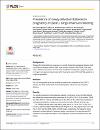Prevalence of newly detected diabetes in pregnancy in Qatar, using universal screening.

Date
2018-08-03Author
Bashir, MohammedE Abdel-Rahman, Manar
Aboulfotouh, Mahmoud
Eltaher, Fatin
Omar, Khalid
Babarinsa, Isaac
Appiah-Sakyi, Kwabena
Sharaf, Tarek
Azzam, Eman
Abukhalil, Mohammad
Boumedjane, Malika
Yousif, Wigdan
Ahmed, Warda
Khan, Sadaf
C Konje, Justin
Abou-Samra, Abdul-Badi
...show more authors ...show less authors
Metadata
Show full item recordAbstract
Diabetes first detected during pregnancy is currently divided into gestational diabetes mellitus (GDM) and diabetes mellitus (DM)- most of which are type 2 DM (T2DM). This study aims to define the prevalence and outcomes of diabetes first detected in pregnancy based on 75-gram oral glucose tolerance test (OGTT)using the recent WHO/IADPSG guidelines in a high-risk population. This is a retrospective study that included all patients who underwent a 75 g (OGTT) between Jan 2016 and Apr 2016 and excluded patients with known pre-conception diabetes. The overall prevalence of newly detected diabetes in pregnancy among the 2000 patients who fulfilled the inclusion/exclusion criteria was 24.0% (95% CI 22.1-25.9) of which T2DM was 2.5% (95% CI 1.9-3.3), and GDM was 21.5% (95% CI 19.7-23.3). The prevalence of newly detected diabetes in pregnancy was similar among the different ethnic groups. The T2DM group was older (mean age in years was 34 ±5.7 vs 31.7±5.7 vs 29.7 ±5.7, p<0.001); and has a higher mean BMI (32.4±6.4 kg/m2 vs 31.7±6.2 kg/m2 vs 29.7± 6.2 kg/m2, p< 0.01) than the GDM and the non-DM groups, respectively. The frequency of pre-eclampsia, pre-term delivery, Caesarean-section, macrosomia, LGA and neonatal ICU admissions were significantly higher in the T2DM group compared to GDM and non-DM groups. Diabetes first detected in pregnancy is equally prevalent among the various ethnic groups residing in Qatar. Newly detected T2DM carries a higher risk of poor pregnancy outcomes; stressing the importance of proper classification of cases of newly detected diabetes in pregnancy.
Collections
- Public Health [514 items ]

